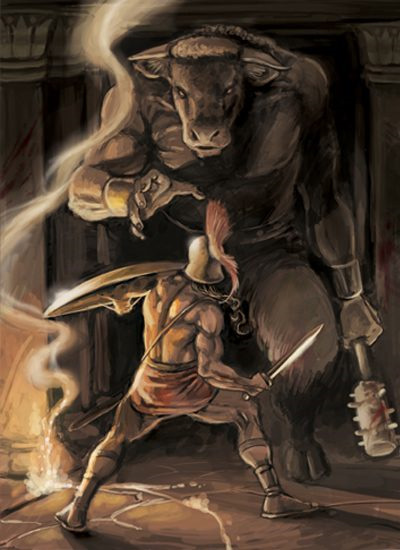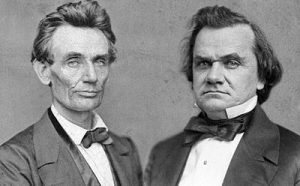Theseus was a Greek hero and was the son of Aethra, princess of Troezen, and daughter of king Troezen. His father was Aegeus, the king of Athens, though there are stories that say that Poseidon, the god of the sea, was Theseus’s father. Theseus was brought up by his grandfather and lived in Troezen, but at the age of only sixteen, he went to Athens and claimed his father, who he believed was Aegeus. Throughout the journey, Theseus killed many others; however, his greatest victory was still yet to come. He eventually encountered the Minotaur, who was a monster that was half human and half bull.1

The Minotaur was son of Pasiphae, queen of Crete and wife of King Minos of Crete. Queen Pasiphae slept with a bull, which is how the Minotaur came to be. A snow-white bull had been sent to King Minos; however, when King Minos did not sacrifice the bull to Poseidon, Poseidon caused Pasiphae to fall in love with the beautiful bull.2 The product of her love was the monstrous Minotaur. This obviously made Minos upset; however, he did not want to kill the monster. He set the architect Daedalus to create and build a labyrinth that made it impossible for anyone to get out without the help of someone else.3
In the labyrinth, the Minotaur was fed young humans, along with several of Minos’ enemies. These humans were victims of Minos, who were forcibly sent by Athens as tribute. Every year, Minos would have seven boys and seven girls sent to the labyrinth, and each year none of the several tributes would return. Once in Crete, they were devoured by the monster-like, blood-thirsty Minotaur. One day, Theseus decided that he would be the one to finally come back out of the labyrinth and end this practice. He, unlike others, volunteered himself as one of the victims. Theseus and the other several hostages sailed for Crete. When Theseus arrived in Crete, he was greeted as the doomed by several locals, and among the crowd was Ariadne, the daughter of King Minos, who immediately fell in love with Theseus and came up with a plan to help him defeat the Minotaur. She gave Theseus a ball of thread that he would fastened to the door of the maze in the labyrinth and unwind the ball until he reached the Minotaur.4

As Theseus and the other victims entered the labyrinth, the Minotaur was sleeping. He immediately took action and wasted no time in trying to defeat the creature. Theseus had absolutely no weapons, not even a sword. He fought the Minotaur hand-to-hand and succeeded, with his very own bare hands, beating the repulsive creature to death with just one blow from the fist. He then helped the other hostages who were in the labyrinth to safety, using the thread to find his way out. After defeating the Minotaur, Theseus and several other Athenians sailed back to Athens, taking along Ariadne. Though Theseus took Ariadne along with him to Athens, he eventually abandoned her on an island.5
On the way back to Athens, Theseus made a promise to his father that he would change the color of his sails if victory was his. Black meant that he had not made it back and white meant that he had; however, Theseus forgot to do so, causing his father to kill himself out of grief. When Theseus’ father died, he became the king of the city-states of Athens. He was honored for his victories and for his win over the Minotaur. He was also honored for making the kingdom larger.6
- Ancient Greece and Rome: An Encyclopedia for Students, 1998, s.v. “Theseus and the Minotaur,” Carroll Moulton. ↵
- Funk & Wagnalls New World Encyclopedia, 2016, s.v. “Minotaur.” ↵
- UXL Encyclopedia of World Mythology, 2009, s.v. “Theseus.” ↵
- The Greenhaven Encyclopedia of Greek and Roman Mythology, 2002, s.v. “Theseus in the Labyrinth,” by Don Nardo. ↵
- Ancient Greece and Rome : An Encyclopedia for Students, 1998, s.v. “Theseus and The Minotaur,” Carroll Moulton. ↵
- UXL Encyclopedia of World Mythology, 2009, s.v. “Theseus.” ↵



41 comments
Nathan Hudson
Greek myths and legends are as good as stories an get, and you wrote the story well. I knew about the labyrinth and the minotaur, but not of Theseus and his journey. You covered the origins of the minotaur in great detail, which helped make the story more interesting. I don’t understand how Theseus was able to kill the minotaur, no weapons? If he only had to strike him once with his bare hands, he must have been insanely strong, which is why these myths are exactly that: myths.
Peter Coons
I had always wondered how the Minotaur came to be. I had always assumed that he just was, or was willed into existence. I must say it’s less comforting to know that it was conceived in the unholy joining of a woman and a bull, but hey, what can you do? I enjoyed this telling of the Legend of Theseus, and I wonder why this source material has not been adapted into more films. Seems like the perfect material for a horror story. I digress, this article was very well done, and shed some light on a part of Greek mythology that I think is not nearly covered as much as it should be.
Mario Sosa
Very fascinating article and featured image; I was recently reading an article about the Minotaur’s origin and was I left wondering about what happened afterwards, but this article helps clarify that. I have seen several adaptations and variations of the Labyrinth in movies, so I am glad to read about its origin story. It’s unfortunate how Theseus’ father died over miscommunication. Nicely done article, good job!
Sarah Mares
Considering I had a good foundation and understand of the uprising and birth of the mythological minotaur, this article was already easy for me to understand and read. When I was writing my article on the birth of the minotaur, lots of further information would pop up about the legend behind the labyrinth and the minotaur, but I never looked into great detail about it. After reading this article, I found myself now well-informed about a topic that I was wanting to know about but did not get around to exploring. The legend of the minotaur being fed young children as offerings inside the labyrinth is very disturbing and is something that I did not find surprising considering the bad blood which the creature was already born upon.
Tyler Sleeter
Really great article. While I knew of the Minotaur and his labyrinth, I did not know that he consumed everyone that entered the labyrinth, and that no one ever escaped. It is interesting to me that Theseus was able to defeat such a horrible monster with the blow from one hand while the Minotaur was asleep. It is also sad that Theseus forgot to put up the correct sail and his father leapt to his death. I know this is Greek mythology, but I find it odd that a creature half human and half bull eats humans; bulls are herbivores.
Samman Tyata
Great article. I really liked the way how you have managed your article. I also really liked your featured image. I had no any knowledge about the content before but your article helped me a lot to know more about Theseus and the Minotaur. It was interesting to read that, in the labyrinth, the Minotaur was fed young humans, along with several of Minos’ enemies. Furthermore, it is astonishing that Theseus defeated Minotaur hand-to-hand without no any weapons with just one blow from the fist. To sum it up, it was a good read.
Alexis Renteria
This is such an intriguing story and you made sure to touch on the main events that occurred. It always fascinates me when I hear how Theseus killed the Minotaur with just one blow of his own fist. I find it crazy how a simple mistake on Theseus part of putting up the white sail could make his father kill himself because of the grief he felt for his son. Overall, this was a very well written article and it shows the determination and courage Theseus had to be the first to come out of the Labyrinth.
Jasmine Martinez
WOW, this was an amazing article, I really enjoyed reading about this and about how Theseus defeated the bull. It was written so nicely, and flowed so good. Very nice pictures as well as good sentences that made extremely good sense. I am really happy someone finally wrote about Theseus because he is so interesting and this article captured his true importance and it was great. Amazing Job Dayna Valdez!
Karina Nanez
This was a very interesting article to read, I especially like how you tied in the story of Theseus and the Labyrinth in with the origin of the minotaur. This was a very comprehensive story that told how Theseus grew to discover his patronage and fight for his rightful throne. And how unfortunate that his father killed himself out of grief because he believed his son was dead.
Michael Mandujano
This article of Theseus and the Minotaur is well-structure and very interesting. In fact, the featured image influenced my interests in reading this article because it highlights this epic battle. I am aware that the portrayal of a minotaur was a being that is half-man and half bull, but I am curious how this creature was created. However, for Theseus to engage in a bare-handed battle with the minotaur is very heroic.